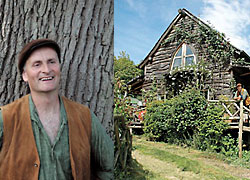An extract from Roundwood Timber Framing
by -:- Ben Law
My interest in building the roundwood frame came from the availability of timber trees growing within my woods.
Being a predominantly coppiced woodland, there were not the volume of straight trees to construct a log building and neither was there an abundance of oak to produce a timber frame.
The roundwood frame was therefore formed, taking its design from the traditional cruck of the British timber frame and using scribing techniques obtained from the log builders of Canada and North America.
What roundwood timber framing offers is an aesthetic frame using far less timber than a log building and far younger trees than a traditional oak frame. It opens up the opportunity to use a variety of timber species and mix them where appropriate within the frame design.
These buildings are designed for the 21st century. They make use of local timber resources, reduce the need to transport timber and building materials over long distances, leave behind the polluting processes of timber preservative and show that foundations can be constructed without the need for concrete.
Above all, the construction process is not complicated and with a bit of practise, the opportunity to empower people to build their own homes from materials around them is an achievable goal.
As I write this, I see a time not far in the future where the conventional building industry and transport haulage systems that move materials around the globe will have ground to a halt. We will need to prioritise our users of the last remaining oil available and will have to rethink how we construct our homes and other buildings.
The need to build from what is around us and the use of draught animals in haulage and hand tools in construction is an area of knowledge we need to refamiliarise ourselves with now.
Learn more about Ben Law’s ‘resource first’ approach to designing buildings at -:- Green Architecture Day 2016.